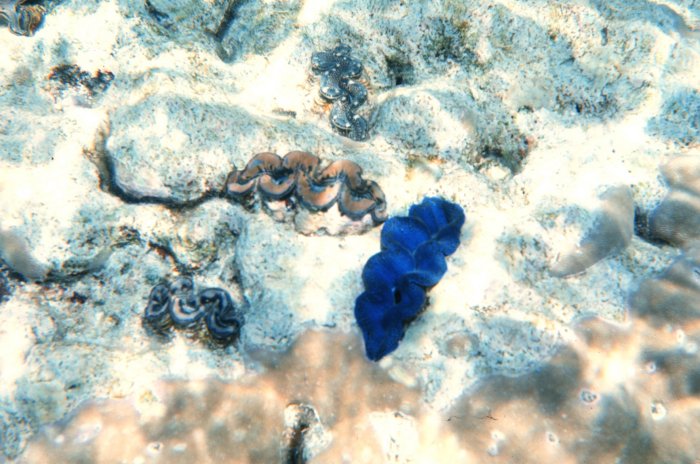
Tridacna crocea - Giant clam embedded in coral Demonstrating
variable
zooxanthellae colorization in mantle
Image ID: reef0021, The Coral Kingdom Collection Location: Palau,
Western Caroline Islands
Photo Date: July 1974 Photographer: Dr. James P. McVey, NOAA
Sea Grant Program
Invertebrate Paleontology Lab #7
Mollusca I: Gastropods and
Bivalves (Pelecypods)
Read BEFORE Coming to Lab:
Benton & Harper, p. 326-344
Introduction
This week we will begin a two week
exploration
of the Molluscan Phylum by examining common fossil gastropods
(snails)
and bivalves (pelecypods). The Mollusc Phylum is of
tremendous
importance to paleontologists, because it includes several classes of
common,
diverse, and easily fossilized organisms. The shells of many
molluscs
represent not only paleoecological information, but also provide
geochemical
information in the form of stable and radiogenic isotope signatures,
trace
element and heavy metal data, and amino acids used in amino acid
racemization
dating. Therefore, finding well preserved fossil molluscs can
lead
to many new ways of obtaining information about your study area or your
research problem.
Molluscan Origins
Early Cambrian molluscan fossils include a very
simple, cap shelled mollusk similar to a limpet, and referred to the
Class
Monoplacaphora. Long thought to have become extinct in Devonian
time,
they were discovered to be living in deep water off of Costa Rica in
the
1950's. This living fossil, Neopilina of the Class
Monoplacaphora
shows faint segmentation, paired gills and other paired organs,
suggesting
that mollusks developed from segmented worms (See Lab# 6), but
secondarily
lost that segmentation.
There are 9 classes of mollusks, which is one indication of their
tremendous
diversity. We will examine the Class Gastropoda and Class
Bivalvia
(Pelecypoda) this week, and the Classes Cephalopoda, Polyplacophora,
and
Scaphopoda next week.
Basic Facts to Know about
Mollusks: They are |
|
| 1. |
Eukaryotes |
| 2. |
Metazoans with organs, true tissues, nervous, muscular,
and reproductive
systems |
| 3. |
characterized by an aragonitic or calcite shell,
precipitated from
the outer layer of the mantle (some internalize the shell) |
| 4. |
characterized by Bilateral Symmetry |
| 5. |
Excellent index fossils: widely distributed,
well preserved,
easily identified, rapidly evolving |
| 6. |
separate sexes or hermaphroditic, with sexual reproduction,
Larvae
are planktonic (mostly) |
| 7. |
found in all known oxygenated aquatic environments,
including
deep marine, fresh water, groundwater, springs and wetlands |
| 8. |
found in many terrestrial environments (you may have
met them
in the garden this summer...) |
| 9. |
found to filter feed, bore, directly feed on sediments,
hunt (carnivores),
scavenge, or parasitize. |
Class Gastropoda (Cambrian-Recent)
The gastropods are molluscs with a distinct head
(with nerve ganglia, eyes), muscular foot (for locomotion) and visceral
mass enclosed in a mantle. The outer portion of the
mantle
is the site of shell formation. Gastropods undergo torsion,
a process in body development that moves the mantle cavity and organs
from
a posterior to an anterior position. In the gastropod life cycle,
this typically occurs in the larval "veliger" stage of development, and the
result is that the anus and organs move forward, the digestive track is twisted
into a "U" shape, and the longitudinal nerve chords twist into a "Figure 8"
shape. Much of the evolutionary diversification in shell form through time
is tied to modifications to accommodate the result of torsion, such as keeping
the head area clear of fouling from exiting waste. The many hypotheses proposed
over the years about why torsion would develop are presented on page 338 in
Benton & Harper text. Interestingly,
some
gastropods have secondarily lost this torsion step, and have reverted
to
the original linear arrangement of organs and mantle cavity. The
shell, composed of aragonite or calcite, and precipitated from the
mantle,
is typically coiled in some way, but not always. The coiling can
be planispiral, (flat in one plane), or trochispiral,
where
the spiral has a "corkscrew" turn. The shells show growth lines, as new
layers of calcite or aragonite are added on with continued growth of
the
gastropod. The tremendous diversity in shell form is linked to
the
wide array of habitats in which gastropods have settled.
Part I A: Look at the gastropod shells in the teaching collection and find
representatives
of the
Order Archaeogastropoda
such as Maclurites, an index fossil for the Ordovician, found
in the Black Hills Ordovician outcrops
Nerites and Haliotis
Order Mesogastropoda
Such as Crepidula, Turritella
Order Neogastropoda
Such as Ecphora, Busycon, Terebra, and Conus
Draw any 2 gastropods, and label the apex, whorl, suture,
and aperture (if visible), noting the Genus name (if available), and
its
Order
and time range.
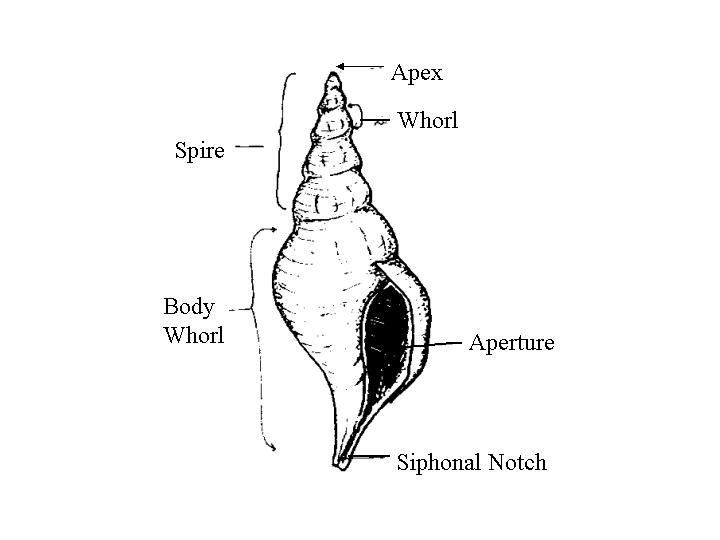
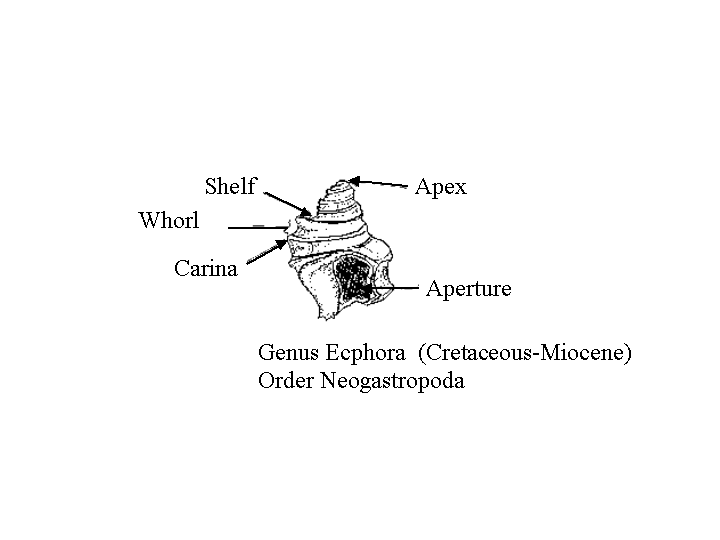
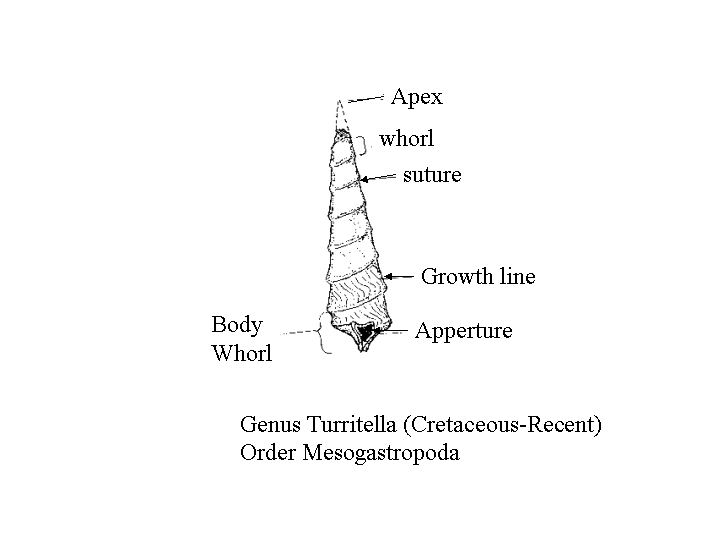
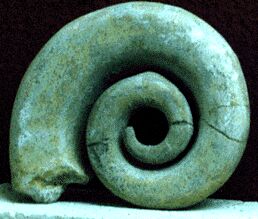
Fossil Maclurites gastropod, image from
http://www.palaeos.com/Invertebrates/Molluscs/Gastropoda/Macluritoidea.html
image source South Dakota School of Mines and Technology -
Museum of Geology
for photos of this gastropod in outcrop, look at this web site by
David
Franzi at SUNY Plattsburgh
http://faculty.plattsburgh.edu/david.franzi/ONSCV/ONSCVmaclurites.htm
Bivalvia (Pelecypoda) (Cambrian-Recent)
Bivalvia are molluscs that at first glance, appear
similar to brachiopods (Paleo Lab #4), but the similarity ends with a
closer
look. The Bivalvia are marked by a symmetry plane
that
passes horizontally between the valves, such that one valve is a mirror
image of the other. The body is headless, and consists of the
visceral
body mass enclosed in a mantle. There is no lophophore, as in the
brachiopods.
The gill structures take up a large amount of the visceral mass, and
these
allow the animal to breathe dissolved oxygen as well as filter
feed.
Interestingly, the paired muscles are adductor muscles only:
that is, they close the shell and hold it in the closed position.
However, when these muscles relax, the stiff ligament along the hinge
area
pops the shell into an open position. Thus, upon death the
bivalves
are easily disarticulated, and are not often found with both
valves
articulated together. Part of the body is developed into a muscular
foot, which is used for digging. The mantle lines the inner
shell,
and precipitates the calcite or aragonite shell. Also, in many
bivalvia,
the mantle is fused into two siphon tubes that direct water in
(inflowing
water for respiration and food) and out (separate siphon for outgoing
waste
water). The mantle, including the siphon, leaves a scar on
the shell interior that is easily identified. The line of the
mantle
is called the pallial line, and the scar of the siphon is
called
the pallial siphon. The adductor muscle scars are
also
very pronounced on the shell interior. Taxonomy is still largely
based on gill structures and on the hinge structure, with the latter
being
useful in paleontology.
We can gain a lot of information about the
sediments
and the paleoenvironment from examining the types of bivalves found in
outcrop. The work of Stanley (1970) has paved the way for a
strong
link between bivalve shell design and their paleoecology &
paleoenvironment.
For example...
From Stanley (1970)
| Bivalvia Shell Shape |
Shell Features |
Siphon Length or adductor muscle size |
Environment |
| highly symmetrical, circular-elongate |
smooth, thin shells |
long siphons |
deep burrowers in soft sediment |
| highly symmetrical, circular-elongate |
sculptured/thick shells, |
short siphons |
shallow borrowers in soft sediment |
| asymmetrical, thin |
thin, often with ridges |
|
borers in hard surfaces (coral, wood) |
| symmetrical, pectenate |
thin, with wing-like projections on hinge
often with radial ribs & plications |
large adductor scars |
swimming bivalves (e.g., scallops) |
| asymmetrical |
thick, spines often present |
one adductor scar |
cemented to hard substrate |
There are 5 subclasses and 12 orders of Bivalvia,
which gives you some idea of their extensive diversity. We will
be
looking at samples from only a few of these orders.
Part IB: Look at the Bivalve specimens and draw any two
of them, labelling the
dentition, the adductor scars, the
pallial
line, the
pallial sinus (if present) and the
beak.
Also label the Genus name, and the Class,
Order, and
type of Dentition, if that information is available. 20
pts.
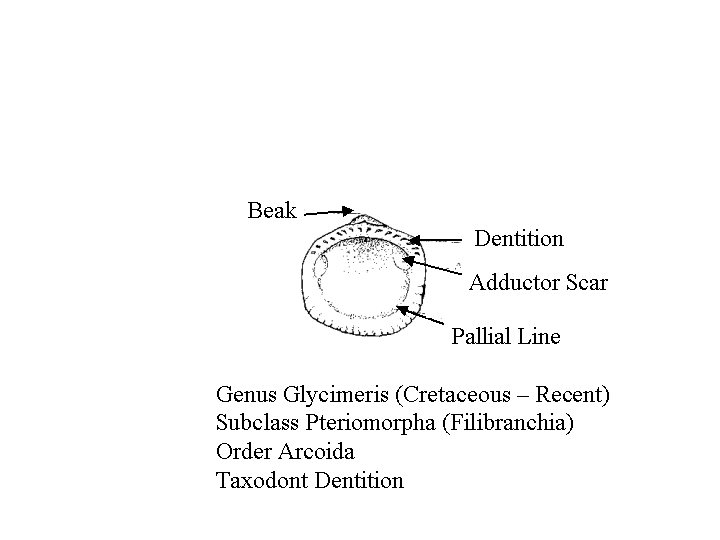
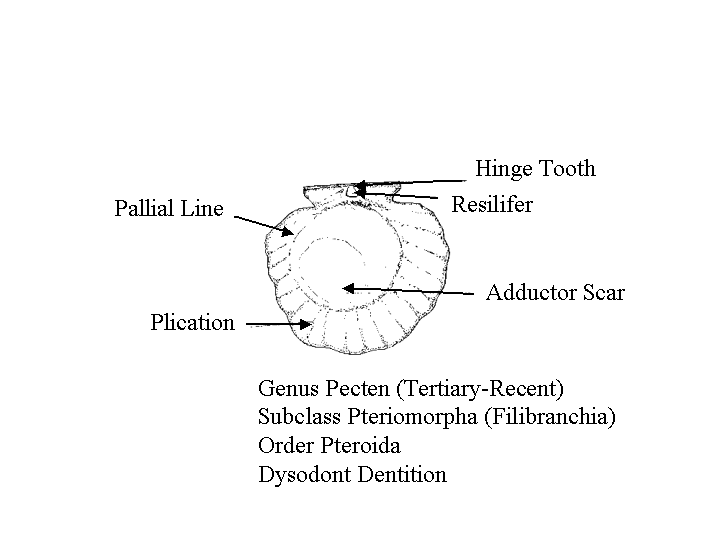
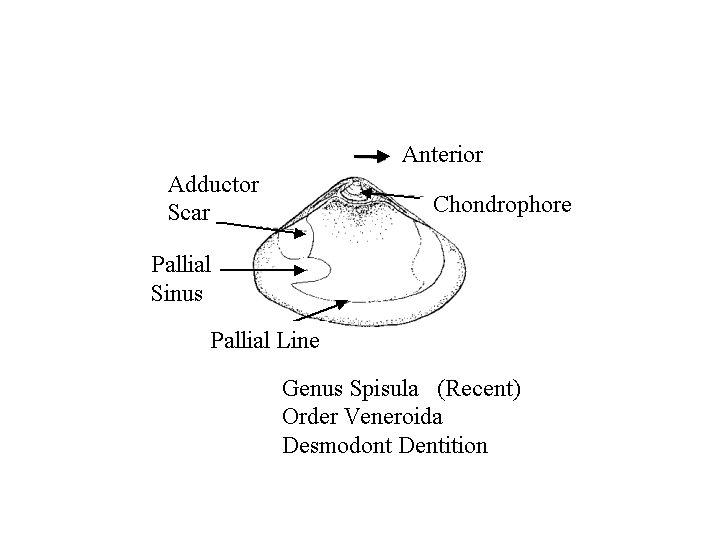
Additional Photos of Living Gastropods and Bivalves from the NOAA Photo
Archive
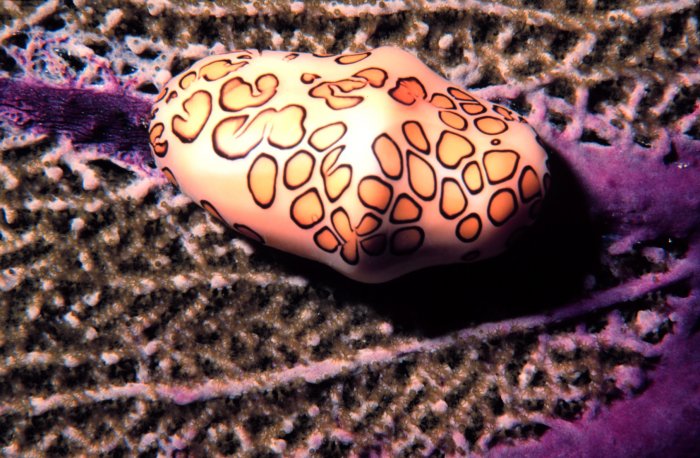 Flamingo
Tongue Snail on a Sea Fan
Flamingo
Tongue Snail on a Sea Fan
Image ID: reef2586, The Coral Kingdom Collection, NOAA
Photographer:
Paige Gill
Credit: Florida Keys National Marine Sanctuary
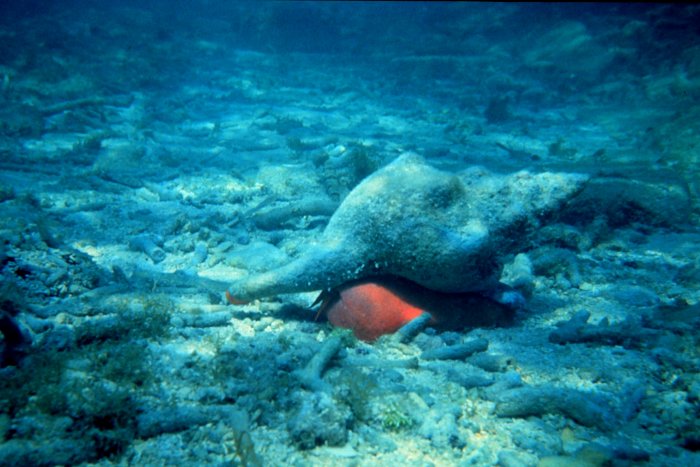
Horse conch in sand and rubble Image ID: reef2587, The Coral
Kingdom Collection
Photographer: Heather Dine Credit: Florida Keys National
Marine
Sanctuary
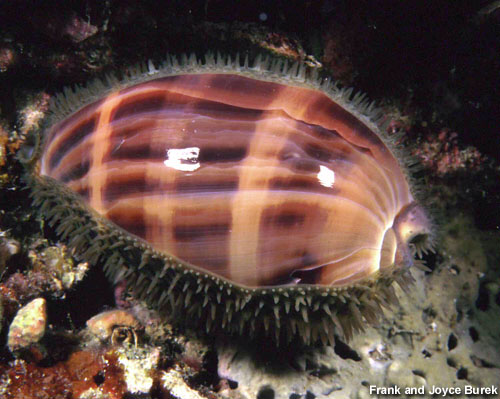
Atlantic deer cowrie (Cypraea cervus) out grazing during your night
dive.
(photo: Frank and Joyce Burek) Flower Garden Banks NMS, NOAA
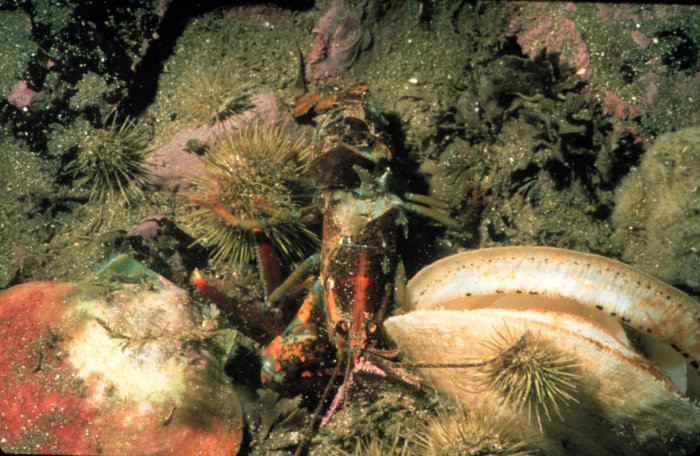
Scallops filter feeding
Image ID: nur01501, National Undersearch Research Program (NURP)
Collection
Location: Boreal Atlantic Ocean, coastal Maine.
Photo Date: 1987 JUly
Photographer: A. Shepard Credit: OAR/National Undersea
Research
Program (NURP);
University of North Carolina at Wilmington
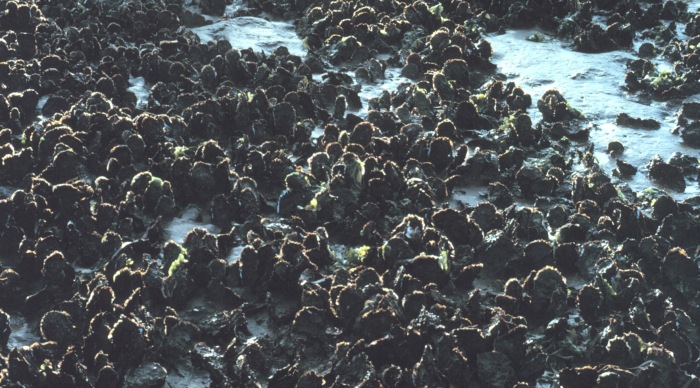
An oyster bed
Image ID: fish0743, Fisheries Collection, NOAA
Location: Willapa Bay, Washington Photo Date: 1969 October
Photographer: Bob Williams
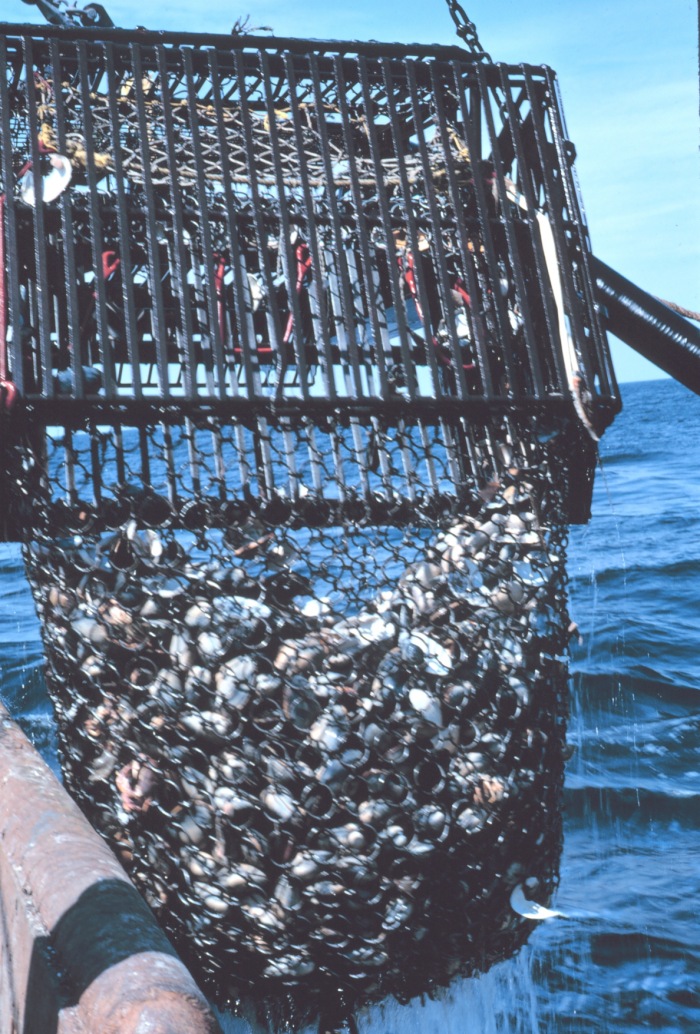
A dredge haul including live clams and empty shells
Image ID: fish0675, Fisheries Collection, NOAA
Location: Cape May, New Jersey, Photo Date: 1968 August
References
Stanley, S. 1970. Relation of shell form to life habits
in the Bivalvia (Mollusca). Geological Society of America Memoir
125,
Boulder, Colorado.








 Flamingo
Tongue Snail on a Sea Fan
Flamingo
Tongue Snail on a Sea Fan




